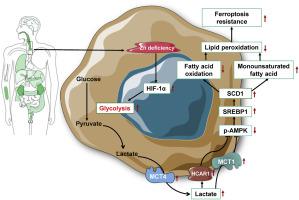当前位置:
X-MOL 学术
›
Free Radical Bio. Med.
›
论文详情
Our official English website, www.x-mol.net, welcomes your feedback! (Note: you will need to create a separate account there.)
Zinc deficiency drives ferroptosis resistance by lactate production in esophageal squamous cell carcinoma
Free Radical Biology and Medicine ( IF 7.4 ) Pub Date : 2024-02-01 , DOI: 10.1016/j.freeradbiomed.2024.01.041 Peiyan Yang , Hui Li , Mingjun Sun , Xinxin Guo , Yinghao Liao , Mohan Hu , Ping Ye , Ran Liu
Free Radical Biology and Medicine ( IF 7.4 ) Pub Date : 2024-02-01 , DOI: 10.1016/j.freeradbiomed.2024.01.041 Peiyan Yang , Hui Li , Mingjun Sun , Xinxin Guo , Yinghao Liao , Mohan Hu , Ping Ye , Ran Liu

|
Trace metal zinc is involved in key processes of solid tumors by its antioxidant properties, while the role of zinc at the onset of esophageal squamous cell carcinoma (ESCC) remains controversial. This study aimed to determine whether zinc is associated with the ESCC and underlying molecular events involving malignant progression. Based on a case-control study, we found serum and urine zinc were decreased and correlated with ESCC progression. Thus, an in vitro model for zinc deficiency (ZD) was established, and we found that ZD contributed to the proliferation, migration, and invasion of EC109 cells. Untargeted metabolomics identified 59 upregulated metabolites and 6 downregulated metabolites, among which glycolysis and ferroptosis-related oxidation of chain fatty acids might play crucial steps in ZD-treated molecular events. Interestingly, ZD disrupted redox homeostasis and enhanced cytosolic Fe of EC109 cells, while lipid peroxidation, the key marker of ferroptosis occurrence, was decreased after ZD treatment. The mechanism underlying these changes may involve ZD-enhanced ESCC glycolysis and lactate production, which confer ferroptosis resistance by inhibiting of -AMPK and leading to the upregulation of SREBP1 and SCD1 to enhance the production of -ferroptosis monounsaturated fatty acids.
中文翻译:

缺锌通过食管鳞状细胞癌中乳酸的产生促进铁死亡抵抗
微量金属锌因其抗氧化特性参与实体瘤的关键过程,而锌在食管鳞状细胞癌(ESCC)发病过程中的作用仍存在争议。本研究旨在确定锌是否与食管鳞癌和涉及恶性进展的潜在分子事件相关。基于病例对照研究,我们发现血清和尿锌下降并与食管鳞癌进展相关。因此,建立了缺锌(ZD)的体外模型,我们发现ZD有助于EC109细胞的增殖、迁移和侵袭。非靶向代谢组学鉴定了 59 种上调的代谢物和 6 种下调的代谢物,其中糖酵解和链脂肪酸铁死亡相关的氧化可能在 ZD 处理的分子事件中发挥关键步骤。有趣的是,ZD 破坏了 EC109 细胞的氧化还原稳态并增强了细胞质 Fe,而脂质过氧化(铁死亡发生的关键标志)在 ZD 处理后减少。这些变化背后的机制可能涉及 ZD 增强的 ESCC 糖酵解和乳酸产生,这通过抑制 -AMPK 并导致 SREBP1 和 SCD1 的上调来增强 β 铁死亡单不饱和脂肪酸的产生,从而赋予铁死亡抗性。
更新日期:2024-02-01
中文翻译:

缺锌通过食管鳞状细胞癌中乳酸的产生促进铁死亡抵抗
微量金属锌因其抗氧化特性参与实体瘤的关键过程,而锌在食管鳞状细胞癌(ESCC)发病过程中的作用仍存在争议。本研究旨在确定锌是否与食管鳞癌和涉及恶性进展的潜在分子事件相关。基于病例对照研究,我们发现血清和尿锌下降并与食管鳞癌进展相关。因此,建立了缺锌(ZD)的体外模型,我们发现ZD有助于EC109细胞的增殖、迁移和侵袭。非靶向代谢组学鉴定了 59 种上调的代谢物和 6 种下调的代谢物,其中糖酵解和链脂肪酸铁死亡相关的氧化可能在 ZD 处理的分子事件中发挥关键步骤。有趣的是,ZD 破坏了 EC109 细胞的氧化还原稳态并增强了细胞质 Fe,而脂质过氧化(铁死亡发生的关键标志)在 ZD 处理后减少。这些变化背后的机制可能涉及 ZD 增强的 ESCC 糖酵解和乳酸产生,这通过抑制 -AMPK 并导致 SREBP1 和 SCD1 的上调来增强 β 铁死亡单不饱和脂肪酸的产生,从而赋予铁死亡抗性。



























 京公网安备 11010802027423号
京公网安备 11010802027423号